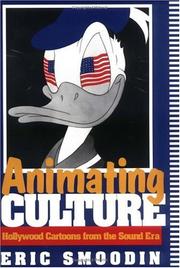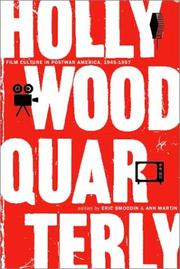| Listing 1 - 5 of 5 |
Sort by
|

ISBN: 0813519497 0813519489 Year: 1993 Volume: *1 Publisher: New Brunswick : Rutgers University Press,
Abstract | Keywords | Export | Availability | Bookmark
 Loading...
Loading...Choose an application
- Reference Manager
- EndNote
- RefWorks (Direct export to RefWorks)
Dessins animés --- Animated films --- Histoire --- Aspect politique --- History and criticism. --- Political aspects --- United States --- History and criticism --- Histoire. --- Dessins animés
Book
ISBN: 9781844574759 184457475X Year: 2012 Publisher: London ; New York : British Film Institute Palgrave Macmillan,
Abstract | Keywords | Export | Availability | Bookmark
 Loading...
Loading...Choose an application
- Reference Manager
- EndNote
- RefWorks (Direct export to RefWorks)
In 1937, when Walt Disney released Snow White and the Seven Dwarfs, the film became an immediate, international sensation. Years earlier, when Disney decided to produce Snow White, his first animated feature-length film, even he couldn't have imagined the hundreds of artists required, the cost involved, or the necessary technological innovations. But all of this effort resulted in a film experience like no other. Fans marvelled at the lush colour palette, the seemingly three-dimensional space, the operatic dependence on songs to tell the story, and the compelling characterisations. Snow White appealed to low and highbrow alike, from the teenagers who invented 'The Dopey Dance' to many of the great museums of the US, which proudly collected celluloid images from the film. Disney's Technicolor cartoon bridged apparent gaps between city and town, between age groups, between classes. Critics celebrated it as an instant classic. Snow White and the Seven Dwarfs now stands as one of the most important of all Hollywood films, and its influence on movies - by Orson Welles, Michael Powell, and many others - extends to the present day. Based on extensive research in materials from the period of the film's production and distribution, Eric Smoodin's study presents a careful history of the events that led up to Snow White, the trajectory of Disney's career that made this extraordinary project a logical next step, the reception of the film in the US and around the world, and its impact on so many aspects of contemporary culture. This special edition of Snow White and the Seven Dwarfs is published to celebrate the 20th anniversary of the BFI Film Classics series.
Animation (cinéma) --- Dessins animés --- Animation (Cinematography) --- Animated films --- Histoire et critique --- History and criticism. --- Snow White and the seven dwarfs (film) --- Snow White and the seven dwarfs (Motion picture) --- Cinematography --- Animated television programs --- History and criticism --- Technique --- #SBIB:309H1320 --- #SBIB:309H1321 --- De filmische boodschap: algemene werken (met inbegrip van algemeen filmhistorische werken en filmhistorische werken per land) --- Films met een amusementsfunctie en/of esthetische functie: algemeen --- Histoire et critique. --- Animation (cinéma) --- Dessins animés
Book
ISBN: 1478007532 9781478007531 1478006927 1478006110 1478090286 Year: 2020 Publisher: Durham ; London : Duke University Press,
Abstract | Keywords | Export | Availability | Bookmark
 Loading...
Loading...Choose an application
- Reference Manager
- EndNote
- RefWorks (Direct export to RefWorks)
"PARIS IN THE DARK traces the history of film and film-going in Paris, from the advent of sound cinema, through the Nazi occupation, and finally to postwar reconstruction. Drawing from a wide range of archives, Eric Smoodin reconstructs a cinematic geography of Paris. Focusing on details of the exhibition and screening of films in the neighborhoods and districts of Paris, Smoodin explores how meaning not only is expressed through film, but also is shaped by the particularities of where, when, and how people engage with film, and how spectators understand their own relationships to film. By paying attention to the material and cultural systems that shape the reception of film on the local level-film journalism, distribution systems, movie theaters - Smoodin revises and expands our understanding of what it means to talk about a national cinema, and about French cinema in particular. The book's chapters take us on a tour of Parisian film from the 1930s to the 1950s. The first chapter focuses on films screened in Parisian cinemas from 1931 to 1933; Smoodin analyzes listings in the film tabloid Pour Vous for evidence of a changing film culture, marked by the transition to sound and the development of a transnational, transcultural cinematic economy. In subsequent chapters Smoodin covers topics ranging from the ciné-clubs of Paris as sites of particular cinematic subcultures (1930-1944), to the impact of sound technology on the emerging stardom of Maurice Chevalier and Marlene Dietrich (1929-1935), to outbreaks of politically motivated violence at the cinema (1930-1944). Focusing more closely on the events of World War II, Smoodin examines how cinema became a form of cultural occupation under the Vichy régime (1939-1944). A final chapter looks at postwar cinema and film-going as an expression and celebration of liberation (1944-1949), while the conclusion considers French government studies of the habits of the national film-going public (1948-1954) in order to reflect on the state of Parisian film culture in more recent decades (1980-2016). PARIS IN THE DARK will interest scholars working in film studies, French culture and history, and cultural studies"--
Motion pictures --- Motion picture theaters --- National characteristics in motion pictures. --- History. --- Culture in motion pictures. --- Paris (France) --- Cinemas --- Movie theaters --- Moving-picture theaters --- Theaters, Motion picture --- Theaters --- Cinema --- Feature films --- Films --- Movies --- Moving-pictures --- Audio-visual materials --- Mass media --- Performing arts --- History and criticism --- cinematic geography --- audience --- film journalism --- film distribution --- exhibition --- World War II --- movie stars

ISBN: 0813307554 0813307562 Year: 1989 Publisher: Boulder, Colo. ; London : Westview,
Abstract | Keywords | Export | Availability | Bookmark
 Loading...
Loading...Choose an application
- Reference Manager
- EndNote
- RefWorks (Direct export to RefWorks)
Jewish-Arab relations --- Jews --- Palestinian Arabs --- Public opinion --- Relations judéo-arabes --- Juifs --- Palestiniens --- Opinion publique --- Public opinion. --- Attitudes. --- Attitudes --- Opinion publique --- Attitudes --- Attitudes --- Israel --- Israël --- Ethnic relations --- Public opinion. --- Relations interethniques --- Opinion publique

ISBN: 0520232739 0520232747 0520936329 9786612762604 159734656X 1282762605 9780520936324 1417525444 9781417525447 9781597346566 9780520232730 9780520232747 9781282762602 6612762608 Year: 2002 Publisher: Berkeley, California University of California Press
Abstract | Keywords | Export | Availability | Bookmark
 Loading...
Loading...Choose an application
- Reference Manager
- EndNote
- RefWorks (Direct export to RefWorks)
The first issue of Hollywood Quarterly, in October 1945, marked the appearance of the most significant, successful, and regularly published journal of its kind in the United States. For its entire life, the Quarterly held to the leftist utopianism of its founders, several of whom would later be blacklisted. The journal attracted a collection of writers unmatched in North American film studies for the heterogeneity of their intellectual and practical concerns: from film, radio, and television industry workers to academics; from Sam Goldwyn, Edith Head, and Chuck Jones to Theodor Adorno and Siegfried Kracauer. For this volume, Eric Smoodin and Ann Martin have selected essays that reflect the astonishing eclecticism of the journal, with sections on animation, the avant-garde, and documentary to go along with a representative sampling of articles about feature-length narrative films. They have also included articles on radio and television, reflecting the contents of just about every issue of the journal and exemplifying the extraordinary moment in film and media studies that Hollywood Quarterly captured and helped to create. In 1951, Hollywood Quarterly was renamed the Quarterly of Film, Radio, and Television, and in 1958 it was replaced by Film Quarterly, which is still published by the University of California Press. During those first twelve years, the Quarterly maintained an intelligent, sophisticated, and critical interest in all the major entertainment media, not just film, and in issue after issue insisted on the importance of both aesthetic and sociological methodologies for studying popular culture, and on the political significance of the mass media.
Motion pictures --- Cinéma --- History --- Social aspects --- Histoire --- Aspect social --- Culture in motion pictures. --- History. --- 20th century. --- academics. --- anthology. --- avant garde film. --- discussion books. --- documentary. --- entertainment. --- essay collection. --- film culture. --- film historians. --- film journalism. --- film scholars. --- film students. --- film studies. --- historical. --- hollywood. --- intellectual perspective. --- journal archives. --- leftist utopianism. --- mass media. --- media studies. --- narrative films. --- nonfiction. --- pop culture. --- postwar america. --- retrospective. --- sociological. --- textbooks. --- united states.
| Listing 1 - 5 of 5 |
Sort by
|

 Search
Search Feedback
Feedback About UniCat
About UniCat  Help
Help News
News